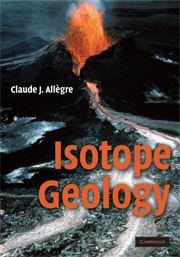Book contents
- Frontmatter
- Contents
- Preface
- Acknowledgments
- Isotopes and radioactivity
- The principles of radioactive dating
- Radiometric dating methods
- Cosmogenic isotopes
- Uncertainties and results of radiometric dating
- Radiogenic isotope geochemistry
- Stable isotope geochemistry
- Isotope geology and dynamic systems analysis
- References
- Appendix
- Further reading
- Solutions to problems
- Index of Names
- Subject Index
Radiogenic isotope geochemistry
Published online by Cambridge University Press: 05 June 2012
- Frontmatter
- Contents
- Preface
- Acknowledgments
- Isotopes and radioactivity
- The principles of radioactive dating
- Radiometric dating methods
- Cosmogenic isotopes
- Uncertainties and results of radiometric dating
- Radiogenic isotope geochemistry
- Stable isotope geochemistry
- Isotope geology and dynamic systems analysis
- References
- Appendix
- Further reading
- Solutions to problems
- Index of Names
- Subject Index
Summary
Our main concern in the previous chapters has been to calculate geological (or cosmological) ages and to clarify their geological meanings. In the next chapters we are going to address isotope geochemistry, which has a markedly different viewpoint although it is based on the same physical laws and on the same equations. We are going to look not at age but at the isotope ratios measured and the ways in which their natural variations may be interpreted.
This chapter, then, focuses on isotope ratios whose variations arise mainly from radioactive decay. Chapter 7 will be about isotope variations caused by physical and chemical processes. Examination of the variations in isotopic ratios will lead us to develop a methodology in which these ratios are used as tracers for major geological and geodynamic phenomena. The purpose of these studies is therefore to determine the major structures and exchanges of matter occurring (or having occurred) among the major terrestrial reservoirs (crust, mantle, core, and atmosphere). The notion of age will crop up again, but in a much more general context, although in complete continuity with the earlier chapters.
Strontium isotope geochemistry
Continents and oceans: granite and basalt
The natural isotopic composition of strontium varies with 87Rb decay. Systematic collation of 87Sr/86Sr isotope compositions of terrestrial basalt and granite (basalt being an isotopic “messenger” from the mantle while granite is a sample of continental crust) reveals very different distributions.
- Type
- Chapter
- Information
- Isotope Geology , pp. 220 - 357Publisher: Cambridge University PressPrint publication year: 2008



